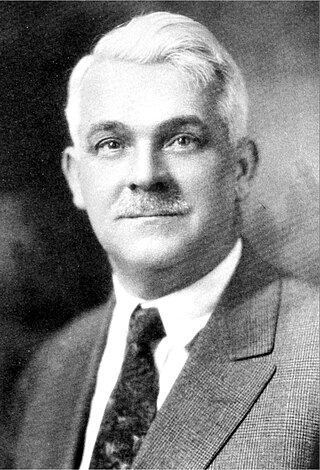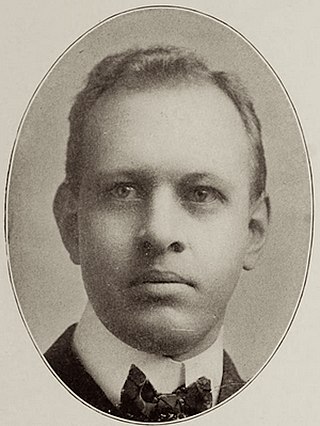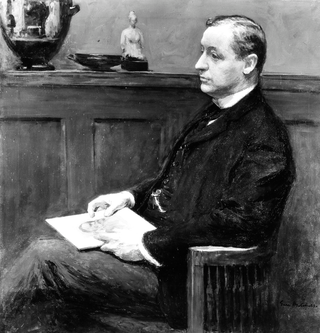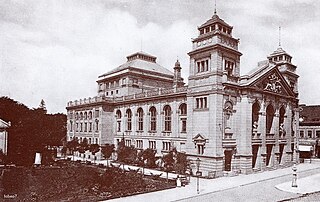
The city of Northampton is the county seat of Hampshire County, Massachusetts, United States. As of the 2020 census, the population of Northampton was 29,571.

The Lobero Theatre is an historic building in Santa Barbara, California. The theater was originally built as an opera house, in a refurbished adobe school building, by Italian immigrant José Lobero in 1873. Located downtown at the corner of Anacapa and Canon Perdido streets, the Lobero Theatre is registered as a California Historical Landmark.

Florence is a village in the northwestern portion of the city of Northampton, Hampshire County, Massachusetts. During the 19th century, Florence was a thriving manufacturing village shaped by progressive ideas on religion, abolitionism, and education.

The Cutler Majestic Theatre at Emerson College, in Boston, Massachusetts, is a 1903 Beaux Arts style theater, designed by the architect John Galen Howard. Originally built for theatre, it was one of three theaters commissioned in Boston by Eben Dyer Jordan, son of the founder of Jordan Marsh, a Boston-based chain of department stores. The Majestic was converted to accommodate vaudeville shows in the 1920s and eventually into a movie house in 1956 by Sack Cinemas. The change to film came with renovations that transformed the lobby and covered up much of John Galen Howard's original Beaux-Arts architecture.

Thomas White Lamb was a Scottish-born, American architect. He was one of the foremost designers of theaters and cinemas of the 20th century.

Charles Adams Platt was an American architect, garden designer, and artist of the "American Renaissance" movement. His garden designs complemented his domestic architecture.

Ernst Moritz Theodor Ziller was a German-born university teacher and architect who later became a Greek national. In the late 19th and early 20th centuries, he was a major designer of royal and municipal buildings in Athens, Patras, and other Greek cities.

William James Dodd (1862–1930) was an American architect and designer who worked mainly in Louisville, Kentucky from 1886 through the end of 1912 and in Los Angeles, California from early 1913 until his death. Dodd rose from the so-called First Chicago School of architecture, though of greater influence for his mature designs was the classical aesthetic of the Beaux-Arts style ascendant after the Chicago World's Columbian Exposition of 1893. His design work also included functional and decorative architectural glass and ceramics, furniture, home appliances, and literary illustration.
The Boston Center for the Arts (BCA) is a 501(c) nonprofit visual and performing arts complex in the South End neighborhood of Boston, Massachusetts. The BCA houses several performance and rehearsal spaces, restaurants, a gallery, the headquarters of the Boston Ballet, the Community Music Center of Boston and several other arts organizations. The BCA also serves as home to four Resident Theater Companies and a number of artists. The BCA's main building, the Cyclorama, is on the National Register of Historic Places. Boston Ballet's headquarters was designed in 1991 by architect Graham Gund.

The Temple Theatre is a historic theater, located on the banks of the Saginaw River in Saginaw, Michigan. The Temple was built in 1927 for the Elf Khurafeh Shriners, and operated for 50 years by W. S. Butterfield Theatres. The theatre complex also contains the former clubhouse of the Elf Khurafeh Shrine, now in use as event space.

Miller Symphony Hall is a 1,100-seat performing arts facility in Allentown, Pennsylvania that hosts the Allentown Symphony Orchestra. The hall was previously known as Central Market (1896), Lyric Theater (1899), and Allentown Symphony Hall (1959). In 2012, it was renamed for the Miller family, longtime owners of the hall and of The Morning Call newspaper.

Municipal Theatre of São Paulo is a theatre in São Paulo, Brazil. It is regarded as one of the landmarks of the city, significant both for its architectural value as well as for its historical importance, having been the venue for the Week of Modern Art in 1922, which revolutionised the arts in Brazil. The building now houses the São Paulo Municipal Symphonic Orchestra, the Coral Lírico and the City Ballet of São Paulo.
The Maryland Theater was a music venue in Baltimore, Maryland, home to that city's first jazz band, led by John Ridgely. It was originally built for James Lawrence Kernan (1838-1912) as a vaudeville house, in 1903, adjacent to his Hotel Kernan. It included a rathskeller in the basement with some of the first music in town from a "jazz band" led by John Ridgley, at what became known later as "The Marble Bar", a musical venue even up to the 1980s. Located facing West Franklin Street, between North Paca Street and west of North Howard Street, which was one of the fanciest hotels in the city at the time constructed of Beaux Arts/Classical Revival style architecture. Unfortunately, in the 1950s, the old Maryland Theatre was razed and temporarily replaced by a parking lot for the last days of the hotel.

The Frank Newhall Look Memorial Park, commonly referred to as Look Park, is a privately run non-profit park in the village of Florence in Northampton, Massachusetts in Hampshire County. The park is open year-round.
The Board Alley Theatre (1792–1793) was an illegal theatre in Boston, Massachusetts in the late 18th century. Also called the New Exhibition Room, it was located in Board Alley in the Financial District. Although some in town supported the theatre, others vehemently opposed it. Governor John Hancock forced it to close in June 1793.

The Boston Opera House, also known as the Citizens Bank Opera House, is a performing arts and esports venue located at 539 Washington St. in Boston, Massachusetts. It was originally built as the B.F. Keith Memorial Theatre, a movie palace in the Keith-Albee chain. The chain became part of RKO when it was established just before the theater opened on October 29, 1928, and it was also known as the RKO Keith's Theater. After operating for more than 50 years as a movie theater, it was rededicated in 1980 as a home for the Opera Company of Boston, which performed there until the opera company closed down in 1990 due to financial problems. The theater was reopened in 2004 after a major restoration, and it currently serves as the home of the Boston Ballet and also hosts touring Broadway shows.

Louis Frederick Grell was an American figure composition and portrait artist based in the Tree Studio resident artist colony in Chicago, Illinois. He received his formal training in Europe from 1900 through 1915 and later became art professor at the Chicago Academy of Fine Arts from 1916 to 1922, and at the Art Institute of Chicago from 1922 to 1934. Grell exhibited his works throughout Europe from 1905 to 1915, in San Francisco in 1907, and in Chicago at the Art Institute 25 times from 1917 to 1941. He exhibited in New York in 1915 and 1916 and in Philadelphia and Washington DC. Primarily an allegorical and figurative composition muralist and portrait painter, his creative strokes adorn the ceilings and walls of numerous US National Historic Landmark buildings.

Charles Lawrence Hutchinson was a Chicago business leader and philanthropist who is best remembered today as the founding and long-time president of the Art Institute of Chicago.

The Municipal Theatre of Bydgoszcz is a former theatre building which stood in Bydgoszcz, Poland from 1896 to 1946.

Bydgoszcz displays an abundant variety of architectures, with styles from neo-gothic, neo-baroque and neoclassicism, to Art Nouveau and modernism; hence its nickname of Little Berlin at the start of the 20th century. The notable granaries on Mill Island and along Brda river also recall a recognized timber-framed characteristics of the city in Poland.


















